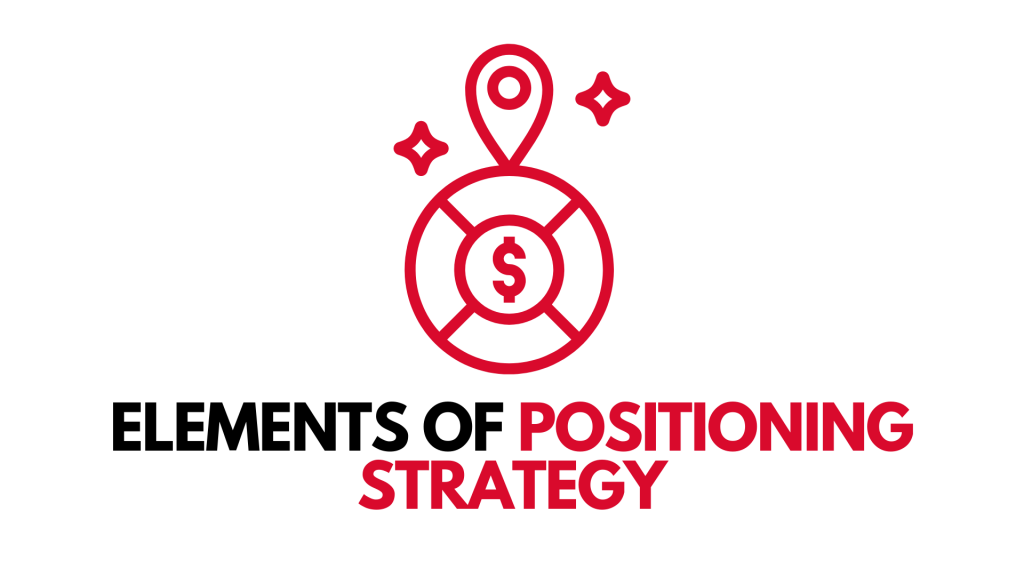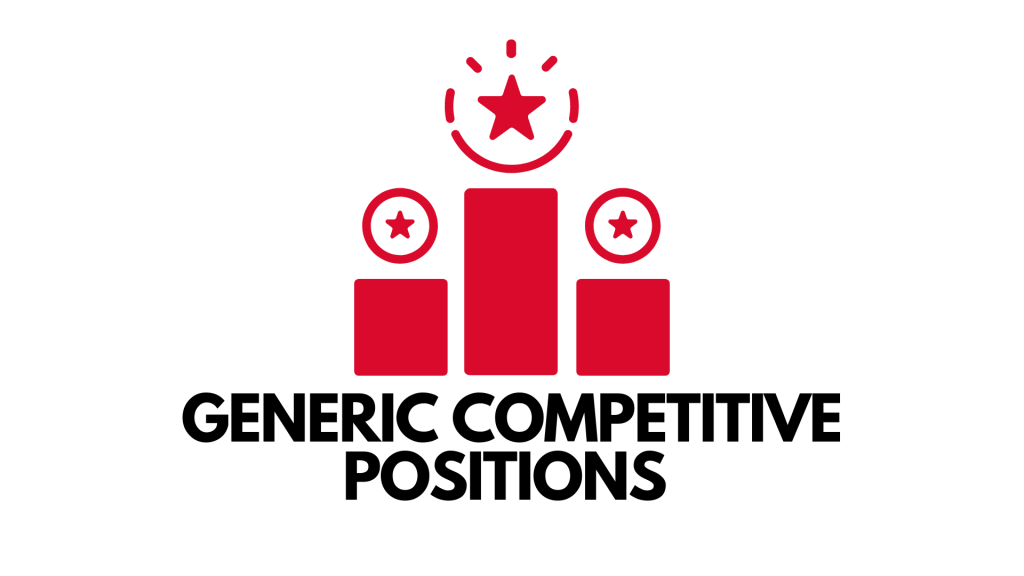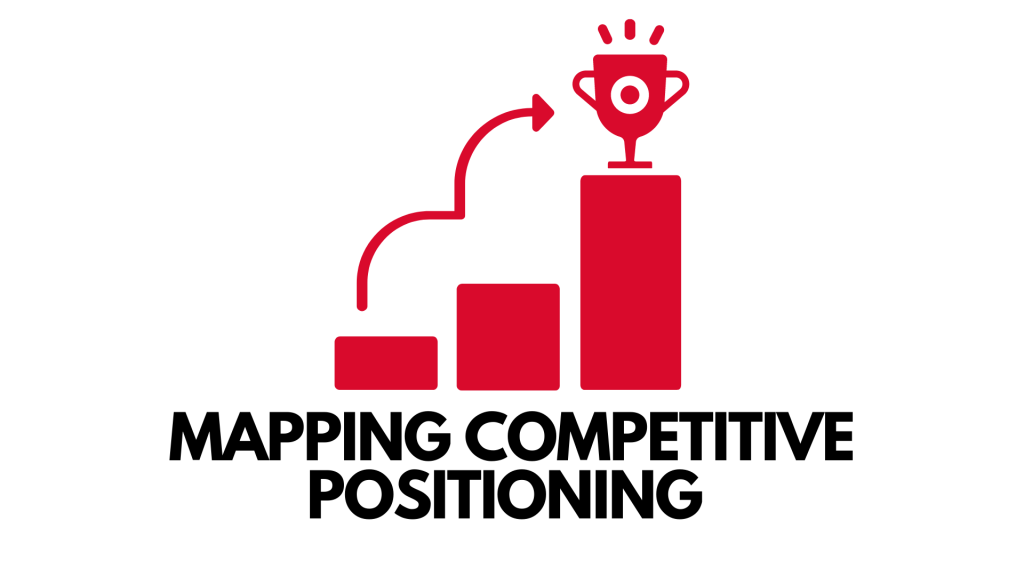The final part of the article on Business Strategy mostly talks about determining competitive positioning, whether it be generic competitive positions or even mapping competitive positions.
Competitive positioning is a marketing strategy related to how a company’s marketing team may set itself apart from its rivals. The company’s position is determined by how its goods and services compare to the value of similar goods and services. Competitive positioning aims to boost sales by increasing your company’s value to customers. Finding a niche for your company’s products to appeal to the unique needs of its clients is a typical example of this. This reduces your competition and allows you to promote to a market interested in your products.

To be good with positioning, there are some elements one should be aware of.
Elements of a Positioning Strategy

1. Market for the Products
To establish where your organization and product fit in the market, consider all market facets. For example, suppose your product’s market is large or small, what stage of growth it is in, and how many competitors you have while learning how to improve your company’s performance.
2. Wants of the Audience
Learn how to effectively sell to your target audience’s specific demands by using analytics and social media, and you’ll be able to outperform the competition. Then, with new angles, additional features, and technical information, use this expertise to improve your products and marketing strategies.
3. Performance of the Company
Because the success of your marketing initiatives is influenced by your company’s performance, consider employing tools like SWOT analysis to assess your company’s performance. SWOT analysis, which stands for strengths, weaknesses, opportunities, and threats, can help you estimate your company’s market potential.
4. Value of the Product
Examine the price point and the product’s benefits to see how much value your product offers for customers. If the price of your product corresponds to its capabilities, you may have a competitive advantage over competitors who charge more for less beneficial effects.
Cost leadership, distinctiveness, and focus are three generic techniques for generating above-average performance in the industry, based on the two primary categories of competitive advantage and the scope of activities a firm aspires to accomplish.
Generic Competitive Positions

Whether a company’s profitability is above or below the industry average is determined by its relative position within the industry. A sustained competitive advantage is a foundation for above-average profitability in the long run. A corporation can have one of two competitive advantages: low cost or differentiation. Cost leadership, distinctiveness, and focus are three generic techniques for generating above-average performance in the industry, based on the two primary categories of competitive advantage and the scope of activities a firm aspires to accomplish. There are two types of focus strategies: cost focus and differentiation focus.
1. Cost Leadership
Cost leadership refers to a company’s goal of becoming the lowest-cost producer in its industry. Cost advantages can come from various places, depending on the industry’s structure. The quest for economies of scale, proprietary technology, privileged access to raw materials, and other considerations may be among them. A low-cost producer must identify and use all cost advantages available. If a company can attain and maintain overall cost leadership, it will outperform the industry average, assuming it can command pricing at or near the industry average.
2. Differentiation
A company aims to be distinctive in its business with a differentiation strategy on a few key aspects that buyers value. It chooses one or more traits that many buyers in a given industry consider vital and positions itself to address those demands distinctively. It is compensated for its rarity with a premium price.
3. Focus
The focus strategy is based on selecting a small competitive scope within a specific industry. The focuser chooses an industry segment or collection of features and tailors its approach to serve them at the expense of others. There are two variants of focus. A company with a cost emphasis seeks a cost advantage in its target market. Differentiation focuses on a firm seeks differentiation in its target segment.
When determining competitive and generic competitive positions, competitive mapping positions is also essential.
Mapping Competitive Positioning

A competitive positioning map visually represents how companies, goods, and services compare. This comparison employs a combination of two factors that buyers consider when making a purchase choice.
It’s nearly impossible for organizations to define their competitive positions if customers don’t know what they’re paying for and management doesn’t know what they’re billing for. As a result, we’re often perplexed and concerned when I ask senior executives to map the positions of their company’s brands against those of essential competitors.
Different executives place their company’s offerings on a price-benefit map in various places; few executives understand their product’s fundamental value, and they all overestimate the benefits of their own offerings while underestimating those of competitors.
In industries like consumer electronics, where the sheer number of features makes comparisons difficult; in markets like computer hardware, where technologies and strategies change frequently; and when products, such as insurance policies, are intangible, the lack of understanding about competitive positions is palpable.
Conclusion
We use strategy to help us define our company and give it a set of values and a sense of purpose. It helps us understand what success implies. It acts as a road map for our business, indicating where we’re headed and where we should stop along the way.
The particular financial and non-financial objectives and results that a firm seeks to attain over a specific period, usually the next three to five years, are strategic goals.
Not every company gets it correctly the first time. For various reasons, all organizations have inherent flaws. A business plan attempts to address these flaws so that organizations do not become tripped up and incur undue consequences. Strategies examine future dangers and aid in developing strategies for overcoming them.
